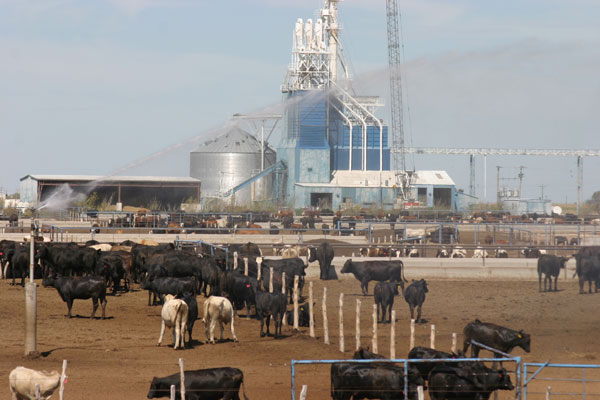January 15, 2015

Animal feeding operations (AFO) are often presented by media in an unfavorable light. There are, indeed, environmental challenges to which animal agriculture can be a contributor, including polluted runoff, nitrate leaching, and ammonia and methane emissions to the atmosphere. However, media sensationalism can give the impression that the livestock feeding industry is lightly regulated, rarely inspected and the source of an enormous amount of water quality pollution. The reality is different.
AFOs are regulated at both the federal and state level, while local governments can also impose additional requirements. The Environmental Protection Agency (EPA) delegates its authority to states that develop their own compliance and permitting programs. By law, a state's regulations must be at least as strict as the federal rule. States that have received delegated authority have primary responsibility for ensuring that AFOs and larger Concentrated Animal Feeding Operations (CAFOs) abide by the rules.
Those rules are codified in each state's regulations, which describe in detail how AFOs must protect the environment. They typically begin with the requirement that CAFOs register with the state and pay an annual fee.
All CAFOs must also develop site-specific plans that describe how surface and groundwater will be protected. Runoff and process-generated wastewater must be contained in impoundments designed to hold at least the 25-year, 24-hour storm runoff volume, along with additional storage capacity for water generated through processes such as equipment washing and milking barn cleaning.

BEEF Seedstock 100
Looking for a new seedstock provider? Use our BEEF Seedstock 100 listing to find the largest bull sellers in the U.S. Browse the Seedstock 100 list here.
The plans must describe how all waste is managed. In most cases, waste materials – manure and wastewater – are applied on fields to provide nutrients for growing crops. This practice recycles nutrients and improves soil quality. The application rate of manure and wastewater must be balanced with the nutrient needs of the crop. To ensure this happens, waste products and land application field soils must be tested annually by a certified laboratory. The laboratory results are used to calculate the correct rate of application of manure and wastewater.
Additionally, nitrogen and phosphorus transport assessments must be prepared for each land application field. Nitrogen – in the form of nitrate – is subject to leaching. Phosphorus is subject to removal via erosion. The transport assessments quantify the risk associated with applying manure or wastewater on a field. If the risk level turns out to be high, the rate of application must be reduced or even discontinued until the level is lowered.
When applying manure or wastewater, CAFOs are required to maintain setback distances from surface water and wells. Land application equipment, such as manure spreaders and sprinkler systems, must be calibrated annually before waste material is applied. The date of calibration and the method used must be documented by the CAFO operator.
If manure or wastewater is transferred to farmers or other parties, the CAFO operator must track the names of all recipients and provide each of them with a copy of the most recent laboratory test results. This allows the recipients to apply the material at an optimal rate.
To protect groundwater, all wastewater impoundments must be equipped with low-permeability liners. The liner of each impoundment must be tested to determine that it complies with the regulation, and the results must be certified by a professional engineer. Groundwater monitoring wells, located down-gradient of impoundments, are also required in some states.
At least once per week, the CAFO operator must inspect and record the liquid depth and liner integrity of each wastewater impoundment. Adequate storage capacity must be maintained to ensure the impoundment system can hold the runoff generated by the design storm, which is usually the greater of the 25-year, 24-hour storm or the 10-day, 10-year storm for the area. Any threats to impoundment liner integrity, such as deep-rooted vegetation, must be corrected.
When waste storage structures are cleaned, a standard operating procedure (SOP) must be followed. The facility owner must certify that the procedure(s) used to clean the impoundment are/were in compliance with the facility's SOP.
Records of all impoundment inspections, land application activities, laboratory test results, manure transfers, field agronomic balance worksheets, storage structure cleaning events and a host of other data must be maintained on site for at least five years and made available for inspection by the state or EPA upon request. Regarding inspections, the state or its contractor inspects all CAFOs on a rotating basis. Deficiencies noted during an inspection are identified as corrective actions which the CAFO owner must address within a specific time period. If problems are not timely corrected, the state may bring enforcement action against the facility, which can include fines and penalties.
The cattle feeding industry has made dramatic progress over the last two decades in making sure that waste products are properly handled, stored and recycled. These improvements have resulted in increased environmental protection and better use of valuable nutrients, such as nitrogen and phosphorus. And, research is ongoing to further reduce the impact of animal agriculture on the environment, and improve operational sustainability.
Phil Brink, CEP, is the founder of BRINK, Inc. (www.brinkinc.biz) which has been providing environmental compliance and conservation services to the agricultural industry since 2002. Contact Phil at (720) 887-9944 or [email protected].
You might also like:
100 biggest seedstock producers in the U.S.
70 photos honor the hardworking cowboys on the ranch
It's the cowboys turn in the market driver's seat
Seedstock 100: Meet the U.S. cattle industry's biggest bull operation
5 biggest themes for the U.S. cattle industry in 2014
9 ranch management concepts to improve your ranch
You May Also Like

.png?width=300&auto=webp&quality=80&disable=upscale)
.png?width=300&auto=webp&quality=80&disable=upscale)
